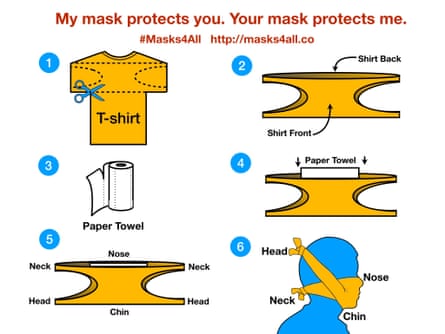The US Centers for Disease Control recommends that all Americans wear face masks in public to reduce transmission of Covid-19. The agency maintains that “it is critical to emphasize that maintaining 6-feet social distancing remains important to slowing the spread of the virus,” and advises that simple cloth coverings can prevent people who may be infected without knowing it from transmitting the virus to others.
Jeremy Howard, a University of San Francisco researcher and the co-founder of Masks 4 All, explains how to create your own, with no sewing required.
Version one – the T-shirt facemask:

Start with an old T-shirt, preferably 100% cotton – anything will do, as long as it’s not too thin – and outline the pattern of the mask. The bottom line should go just beneath the armpits of the shirt. Make sure the part that goes on your face is large enough to cover your nose and mouth.
Cut along the lines through both sides of the shirt so that your mask has two layers.
Place a safety pin along the bottom and insert a piece of paper towel or coffee filter in between the two layers of the T-shirt. This acts as an additional filter, and rests on top of the safety pin.
Secure the mask around the front of your face, covering your nose and mouth. Tie the top straps under the back of your head and the bottom straps at the top of your head. That will ensure a nice fit underneath your chin. By covering your mouth, you have now protected those around you, and the better the fit, the more you’re going to also protect yourself.
Version two – the handkerchief face mask:
Start with a handkerchief and two hair ties. Rubber bands are okay as well, although they will be less comfortable.
Fold the handkerchief in half, along a horizontal axis, and make a nice crease.
Place piece of paper towel or coffee filter at the center of the handkerchief. Fold the top down and the bottom up, so that the coffee filter or paper towel rests in the fold.
Place your first elastic about one-third of the way in from the edge of the handkerchief. Place the second elastic one-third of the way in from the other side. The two elastics should be about one hand-width apart.
Fold the left side in toward the center and then fold the right side in toward the center, tucking the right side into the left-side flap.
Using and taking care of your mask:
Don’t wear it at home, and don’t wear it in the car, unless you’re with people outside your regular family group. Don’t wear it more than necessary – just wear it when you’re in a public place, like a supermarket, where you might be within 6ft of people. It may not be necessary in a park or on a quiet street with few pedestrians, when you’re moving around.
Don’t remove the mask until you’re at home or in a place where you can wash your hands and avoid coming within 6ft of other people. When you do remove the mask, avoid touching the front of it in case you breathed in infected droplets that could now be there.
Remove and dispose of the paper towel insert. Place the rest of the mask in soapy water, soak it for two minutes, then wash and rinse. Any kind of soap – dish soap, laundry detergent, hand soap – will do. Then wash your hands, and disinfect with bleach or alcohol anything you touched after taking off the mask. Never reuse a mask without washing it first.
Next time you wear the mask, remember to replace the paper-towel insert.
If you have symptoms – a stuffy nose, a cough, a fever – stay inside.